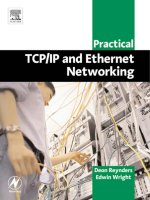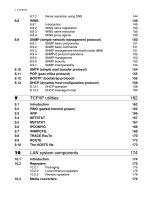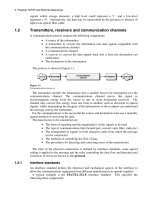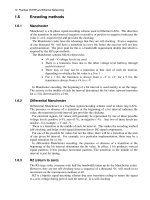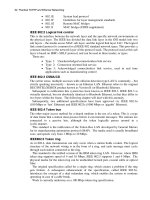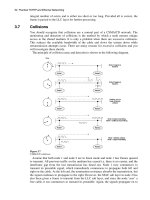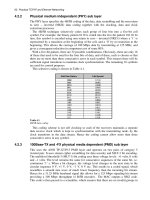Practical TCP/IP and Ethernet Networking- P6 pdf
Bạn đang xem bản rút gọn của tài liệu. Xem và tải ngay bản đầy đủ của tài liệu tại đây (219.12 KB, 10 trang )
6XGIZOIGR:)6/6GTJ+ZNKXTKZ4KZ]UXQOTM
• 802.1E System load protocol
• 802.1F Guidelines for layer management standards
• 802.1G Remote MAC bridges
• 802.1I MAC bridges (FDDI supplement)
/+++2UMOIGRROTQIUTZXUR
This is the interface between the network layer and the specific network environments at
the physical layer. The IEEE has divided the data link layer in the OSI model into two
sub layers – the media access MAC sub layer, and the logical link layer LLC. The logical
link control protocol is common for all IEEE 802 standard network types. This provides a
common interface to the network layer of the protocol stack. The protocol used at this sub
layer is based on IBM’s SDLC protocol, and can be used in three modes, or types.
These are:
• Type 1: Unacknowledged connectionless link service
• Type 2: Connection oriented link service
• Type 3: Acknowledged connectionless link service, used in real time
applications such as manufacturing control
/+++)93')*
The carrier sense, multiple accesses with collision detection type LAN is commonly – but
strictly speaking incorrectly – known as an Ethernet LAN. Ethernet refers to the original
DEC/INTEL/XEROX product known as Version II (or Bluebook) Ethernet.
Subsequent to ratification this system has been known as IEEE 802.3. IEEE 802.3 is
virtually identical, but not absolutely identical to Bluebook Ethernet, in that they differ in
two bytes within the frame. The following chapter will deal with this anomaly.
Subsequently, two additional specifications have been approved viz. IEEE 802.3u
(100 Mbps or ‘fast’ Ethernet) and IEEE 8023z (1000 Mbps or ‘gigabit’ Ethernet).
/+++:UQKTH[Y
The other major access method for a shared medium is the use of a token. This is a type
of data frame that a station must possess before it can transmit messages. The stations are
connected to a passive bus, although the token logically passes around in a
cyclic manner.
This standard is the ratification of the Token Bus LAN developed by General Motors
for its manufacturing automation protocol (MAP). The media used is usually broadband
coax, and speeds vary from 1 Mbps to 10 Mbps.
/+++:UQKTXOTM
As in 802.4, data transmission can only occur when a station holds a token. The logical
structure of the network wiring is in the form of a ring, and each message must cycle
through each station connected to the ring.
This standard is the ratified version of the IBM token ring LAN. However, where IBM
token ring supports speed of 4 and 16 Mbps, IEEE 802.5 supports 1 and 4 Mbps. The
physical media for the token ring can be unshielded twisted pair, coaxial cable or optical
fiber.
The original specification called for a single ring, which creates a problem if the ring
gets broken. A subsequent enhancement of the specification, called IEEE 802.5u,
introduces the concept of a dual redundant ring, which enables the system to continue
operating in case of a cable break.
Work is currently underway on a 100 Mbps token ring specification.
4KZ]UXQOTML[TJGSKTZGRY
/+++3KZXUVUROZGTGXKGTKZ]UXQY
This committee is responsible for defining the standards for MANs. It has recommended
that a system known as distributed queue data bus (DQDB) be utilized as a MAN
standard.
The DQDB network is sponsored by Telecom Australia and defines the protocol for
integrated voice and data on the same medium, within an area up to 15 km in diameter.
/+++(XUGJHGTJ2'4YZKINTOIGRGJ\OYUX_MXU[V:'-
The 802.7 Committee provides technical advice on broadband technique.
/+++,OHKXUVZOI2'4Y:'-
The fiber optic equivalent of the 802.7 broadband TAG. The committee is attempting to
standardize physical compatibility with FDDI and synchronous optical networks
(SONET). It is also investigating single mode fiber and multimode fiber architectures.
/+++/TZKMXGZKJ\UOIKGTJJGZG2'4Y
This committee has recently released a specification for isochronous Ethernet as IEEE
802.9a. It provides a 6.144 Mbps voice service (96 channels at 64 kbps) multiplexed with
10 Mbps data on a single cable. It is designed for multimedia applications.
/+++9KI[XK2'4Y
Current proposals include two methods to address the lack of security in the original
specifications. These are:
• A secure data exchange sub layer SDE sitting between the LLC and the MAC
sub layer. There will be different SDEs for different systems i.e. military and
medical
• A secure interoperable LAN system architecture SILS. This will define
system standards for secure LAN communications
/+++=OXKRKYY2'4Y
The IEEE802.11 Wireless LAN standard uses the 2.4 GHz band and allows operation to 1
or 2 Mbps. The 802.11b standard also uses the 2.4 GHz band, but allows operation at
11 Mbps. The latest IEEE 802.11a specification use the 5.7 GHz band instead and allows
operation at 54 Mbps.
/+++,GYZ2'4Y
This specification covers the system known as 100VG AnyLAN. Developed by Hewlett-
Packard, this system operates on voice grade (CAT3) cable – hence the VG in the name.
The AnyLAN indicates that the system can interface with both IEEE 802.3 and
IEEE 802.5 networks (by means of a special speed adaptation bridge).
4KZ]UXQZUVURUMOKY
(XUGJIGYZGTJVUOTZZUVUOTZZUVURUMOKY
The way the nodes are connected to form a network is known as its topology. There are
many topologies available but they form two basic types, broadcast and point-to-point.
Broadcast topologies are those where the message ripples out from the transmitter to
reach all nodes. There is no active regeneration of the signal by the nodes and so signal
propagation is independent of the operation of the network electronics. This then limits
the size of such networks.
6XGIZOIGR:)6/6GTJ+ZNKXTKZ4KZ]UXQOTM
Figure 2.13 shows an example of a broadcast topology.
Figure 2.13
Broadcast topology
In a point-to-point communications network, however, each node is communicating
directly with only one node. That node may actively regenerate the signal and pass it on
to its nearest neighbor. Such networks have the capability of being made much larger.
Figure 2.14 shows some examples of point-to-point topologies.
Figure 2.14
Point-to-point topologies
2UMOIGRGTJVN_YOIGRZUVURUMOKY
A logical topology defines how the elements in the network communicate with each
other, and how information is transmitted through a network. The different types of
media-access methods, determine how a node gets to transmit information along the
network. In a bus topology, information is broadcast, and every node gets the same
information within the amount of time it actually takes a signal to cover the entire length
of cable. This time interval limits the maximum speed and size for the network. In a ring
topology, each node hears from exactly one node and talks to exactly one other node.
Information is passed sequentially, in an order determined by a predefined process. A
polling or token mechanism is used to determine who has transmission rights, and a node
can transmit only when it has this right.
A physical topology defines the wiring layout for a network. This specifies how the
elements in the network are connected to each other electrically. This arrangement will
determine what happens if a node on the network fails. Physical topologies fall into three
main categories bus, star, and ring topology. Combinations of these can be used to form
4KZ]UXQOTML[TJGSKTZGRY
hybrid topologies to overcome weaknesses or restrictions in one or other of these three
component topologies.
([YZUVURUM_
A bus refers to both a physical and a logical topology. As a physical topology, a bus
describes a network in which each node is connected to a common single communication
channel or ‘bus’. This bus is sometimes called a backbone, as it provides the spine for the
network. Every node can hear each message packet as it goes past.
Logically, a passive bus is distinguished by the fact that packets are broadcast and every
node gets the message at the same time. Transmitted packets travel in both directions
along the bus, and need not go through the individual nodes, as in a point-to-point system.
Rather, each node checks the destination address that is included in the message packet to
determine whether that packet is intended for the specific node. When the signal reaches
the end of the bus, an electrical terminator absorbs the packet energy to keep it from
reflecting back again along the bus cable, possibly interfering with other messages
already on the bus. Each end of a bus cable must be terminated, so that signals are
removed from the bus when they reach the end.
In a bus topology, nodes should be far enough apart so that they do not interfere with
each other. However, if the backbone bus cable is too long, it may be necessary to boost
the signal strength using some form of amplification, or repeater. The maximum length of
the bus is limited by the size of the time interval that constitutes ‘simultaneous’ packet
reception. Figure 2.15 illustrates the bus topology.
Figure 2.15
Bus topology
([YZUVURUM_GJ\GTZGMKY
Bus topologies offer the following advantages:
• A bus uses relatively little cable compared to other topologies, and arguably
has the simplest wiring arrangement
• Since nodes are connected by high impedance tappings across a backbone
cable, it’s easy to add or remove nodes from a bus. This makes it easy to
extend a bus topology
• Architectures based on this topology are simple and flexible
• The broadcasting of messages is advantageous for one-to-many data
transmissions
([YZUVURUM_JOYGJ\GTZGMKY
These include the following:
• There can be a security problem, since every node may see every message,
even those that are not destined for it
• Diagnosis/troubleshooting (fault-isolation) can be difficult, since the fault
can be anywhere along the bus
6XGIZOIGR:)6/6GTJ+ZNKXTKZ4KZ]UXQOTM
• There is no automatic acknowledgment of messages, since messages get
absorbed at the end of the bus and do not return to the sender
• The bus cable can be a bottleneck when network traffic gets heavy. This is
because nodes can spend much of their time trying to access the network
9ZGXZUVURUM_
A star topology is a physical topology in which multiple nodes are connected to a central
component, generally known as a hub. The hub of a star usually is just a wiring center;
that is, a common termination point for the nodes, with a single connection continuing
from the hub. In some cases, the hub may actually be a file server (a central computer
that contains a centralized file and control system), with all its nodes attached directly to
the server. As a wiring center, a hub may, in turn, be connected to the file server or to
another hub.
All signals, instructions, and data going to and from each node must pass through the
hub to which the node is connected. The telephone system is doubtless the best known
example of a star topology, with lines to individual customers coming from a central
telephone exchange location. There are not many LAN implementations that use a logical
star topology. The low impedance ARCnet networks are probably the best examples.
However, you will see that the physical layout of many other LANs look like a star
topology even though they are considered to be something else. An example of a star
topology is shown in Figure 2.16.
Figure 2.16
Star topology
9ZGXZUVURUM_GJ\GTZGMKY
• Troubleshooting and fault isolation is easy
• It is easy to add or remove nodes, and to modify the cable layout
• Failure of a single node does not isolate any other node
• The inclusion of a central hub allows easier monitoring of traffic for
management purposes
9ZGXZUVURUM_JOYGJ\GTZGMKY
• If the hub fails, the entire network fails. Sometimes a backup central
machine is included, to make it possible to deal with such a failure
• A star topology requires a lot of cable
8OTMZUVURUM_
A ring topology is both a logical and a physical topology. As a logical topology, a ring is
distinguished by the fact that message packets are transmitted sequentially from node to
4KZ]UXQOTML[TJGSKTZGRY
node, in a predefined order, and as such it is an example of a point-to-point system.
Nodes are arranged in a closed loop, so that the initiating node is the last one to receive a
packet. As a physical topology, a ring describes a network in which each node is
connected to exactly two other nodes.
Information traverses a one-way path, so that a node receives packets from exactly one
node and transmits them to exactly one other node. A message packet travels around the
ring until it returns to the node that originally sent it. In a ring topology, each node can act
as a repeater, boosting the signal before sending it on. Each node checks whether the
message packet’s destination node matches its address. When the packet reaches its
destination, the destination node accepts the message, then sends it back to the sender, to
acknowledge receipt.
As you will see later in this chapter, since ring topologies use token passing to control
access to the network, the token is returned to sender with the acknowledgment. The
sender then releases the token to the next node on the network. If this node has nothing to
say, the node passes the token on to the next node, and so on. When the token reaches a
node with a packet to send, that node sends its packet. Physical ring networks are rare,
because this topology has considerable disadvantages compared to a more practical star-
wired ring hybrid, which is described later.
Figure 2.17
Ring topology
8OTMZUVURUM_GJ\GTZGMKY
• A physical ring topology has minimal cable requirements
• No wiring center or closet is needed
• The message can be automatically acknowledged
• Each node can regenerate the signal
8OTMZUVURUM_JOYGJ\GTZGMKY
• If any node goes down, the entire ring goes down
• Diagnosis/troubleshooting (fault isolation) is difficult because
communication is only one-way
• Adding or removing nodes disrupts the network
• There will be a limit on the distance between nodes
As well as these three main topologies, some of the more important variations will now
be considered. Once again, you should be clear that these are just variations, and should
not be considered as topologies in their own right.
6XGIZOIGR:)6/6GTJ+ZNKXTKZ4KZ]UXQOTM
5ZNKXZ_VKYULZUVURUM_
9ZGX]OXKJXOTMZUVURUM_
A star-wired ring topology, also known as a hub topology, is a hybrid physical topology
that combines features of the star and ring topologies. Individual nodes are connected to a
central hub, as in a star network. Within the hub, however, the connections are arranged
into an internal ring. Thus, the hub constitutes the ring, which must remain intact for the
network to function. The hubs, known as multistation access units (MAUs) in IBM token
ring network terminology, may be connected to other hubs. In this arrangement, each
internal ring is opened and connected to the attached hubs, to create a larger, multi-hub
ring.
The advantage of using star wiring instead of simple ring wiring is that it is easy to
disconnect a faulty node from the internal ring. The IBM data connector is specially
designed to close a circuit if an attached node is disconnected physically or electrically.
By closing the circuit, the ring remains intact, but with one less node. The IBM token ring
networks are the best-known example of a star-wired ring topology. In token ring
networks, a secondary ring path can be established and used if part of the primary path
goes down. The star-wired ring is illustrated in Figure 2.18.
Figure 2.18
Star-wired ring
The advantages of a star-wired ring topology include:
• Troubleshooting, or fault isolation, is relatively easy
• The modular design makes it easy to expand the network, and makes layouts
extremely flexible
• Individual hubs can be connected to form larger rings
• Wiring to the hub is flexible
The disadvantages of a star-wired ring topology include:
• Configuration and cabling may be complicated because of the extreme
flexibility of the arrangement.
*OYZXOH[ZKJYZGXZUVURUM_
A distributed star topology is a physical topology that consists of two or more hubs, each
of which is the center of a star arrangement. A good example of such a topology is an
4KZ]UXQOTML[TJGSKTZGRY
ARCnet network with at least one active hub and one or more active or passive hubs.
The 100VG ANYLAN utilizes a similar topology.
Figure 2.19
Distributed star topology
3KYNZUVURUM_
A mesh topology is a physical topology in which there are at least two paths to and from
every node. This type of topology is advantageous in hostile environments in which
connections are easily broken. If a connection is broken, at least one substitute path is
always available. A more restrictive definition requires each node to be connected
directly to every other node. Because of the severe connection requirements, such
restrictive mesh topologies are feasible only for small networks.
Figure 2.20
Mesh network
:XKKZUVURUM_
A tree topology, also known as a distributed bus or a branching tree topology, is a hybrid
physical topology that combines features of star and bus topologies. Several buses may be
daisy-chained together, and there may be branching at the connections (which will be
hubs). The starting end of the tree is known as the root or head end. This type of topology
is used in delivering cable television services.
The advantages of a tree topology are:
• The network is easy to extend by just adding another branch, and that fault
isolation is relatively easy
The disadvantages include:
• If the root goes down, the entire network goes down
• If any hub goes down, all branches off that hub go down
• Access becomes a problem if the entire network becomes too big
6XGIZOIGR:)6/6GTJ+ZNKXTKZ4KZ]UXQOTM
Figure 2.21
Tree topology
3KJOGGIIKYYSKZNUJY
A common and important method of differentiating between different LAN types is to
consider their media access methods. Since there must be some method of determining
which node can send a message, this is a critical area that determines the efficiency of the
LAN. There are a number of methods, which can be considered, of which the two most
common in current LANs are the contention method and the token passing method.
You will become familiar with these as part of your study of LANs, although some of the
other methods will also be briefly discussed.
)UTZKTZOUTY_YZKSY
The basis for a first-come-first-served media accesses method. This operates in a similar
manner to polite human communication. We listen before we speak, deferring to anyone
who already is speaking. If two of us start to speak at the same time, we recognize that
fact and both stop, before starting our messages again a little later. In a contention-based
access method, the first node to seek access when the network is idle will be able to
transmit. Contention is at the heart of the carrier sense multiple access/collision
detection (CSMA/CD) access method used in the IEEE 802.3 and Ethernet V2 networks.
The carrier sense component involves a node wishing to transmit a message listening to
the transmission media to ensure there is no ‘carrier’ present. In fact, the signaling
method used on Ethernet type systems that make use of this method do not use a carrier in
its true sense, and the name relates back to the original Aloha project in Hawaii that used
radio links for transmission. The length of the channel and the finite propagation delay
means that there is still a distinct probability that more than one transmitter will attempt
to transmit at the same time, as they both will have heard ‘no carrier’. The collision
detection logic ensures that more than one message on the channel simultaneously will be
detected and transmission, from both ends, eventually stopped. The system is a
probabilistic system, since access to the channel cannot be ascertained in advance.
:UQKTVGYYOTM
Token passing is a deterministic media access method in which a token is passed from
node to node, according to a predefined sequence. A token is a special packet, or frame,
consisting of a signal sequence that cannot be mistaken for a message. At any given time,
the token can be available or in use. When an available token reaches a node, that node
can access the network for a maximum predetermined time, before passing the token on.
4KZ]UXQOTML[TJGSKTZGRY
This deterministic access method guarantees that every node will get access to the
network within a given length of time, usually in the order of a few milliseconds. This is
in contrast to a probabilistic access method (such as CSMA/CD), in which nodes check
for network activity when they want to access the network, and the first node to claim the
idle network gets access to it. Because each node gets its turn within a fixed period,
deterministic access methods are more efficient on networks that have heavy traffic. With
such networks, nodes using probabilistic access methods spend much of their time
competing to gain access and relatively little time actually transmitting data over the
network. Network architectures that support the token passing access method include
token bus, ARCnet, FDDI, and token ring.
To transmit, the node first marks the token as ‘in use’, and then transmits a data packet,
with the token attached. In a ring topology network, the packet is passed from node to
node, until the packet reaches its destination. The recipient acknowledges the packet by
sending the message back to the sender, who then sends the token on to the next node in
the network.
In a bus topology network, the next recipient of a token is not necessarily the node that
is nearest to the current token passing node. Rather, the next node is determined by some
predefined rule. The actual message is broadcast on to the bus for all nodes to ‘hear’. For
example, in an ARCnet or token bus network, the token is passed from a node to the node
with the next lower network address. Networks that use token passing generally have
some provision for setting the priority with which a node gets the token. Higher-level
protocols can specify that a message is important and should receive higher priority.
Figure 2.22
Token passing
A token ring network requires an active monitor (AM) and one or more standby
monitors (SMs). The AM keeps track of the token to make sure it has not been corrupted,
lost, or sent to a node that has been disconnected from the network. If any of these things
happens, the AM generates a new token, and the network is back in business. The SM
makes sure the AM is doing its job and does not break down and get disconnected from
the network. If the AM is lost, one of the SMs becomes the new AM, and the network is
again in business. These monitoring capabilities make for complex circuitry on network
interface cards that use this media access method.
6URROTM
Polling refers to a process of checking elements, such as computers or queues, in some
defined order, to see whether the polled element needs attention (wants to transmit,
contains jobs, and so on). In roll call polling, the polling sequence is based on a list of
elements available to the controller. In contrast, in hub polling, each element simply polls
the next element in the sequence.
